
|
|
January 16-23, 2002
Tracking the old Rural Radio Network
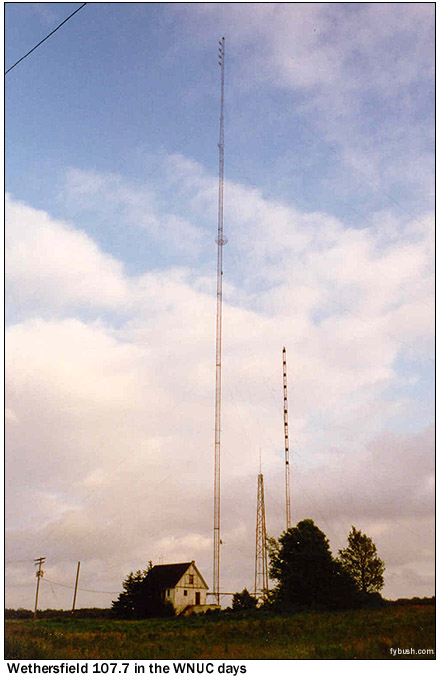 More than fifty years
ago, long before FM radio was a household word in most of America,
the airwaves of upstate New York lit up with some of the nation's
first FM broadcasts.
More than fifty years
ago, long before FM radio was a household word in most of America,
the airwaves of upstate New York lit up with some of the nation's
first FM broadcasts.
The Rural Radio Network built six stations in small towns around the state, creating a network that was decades ahead of its time. Well aware that the farmers who were its target audience didn't have FM radios, RRN went into the equipment business as well, selling inexpensive FM receivers to would-be listeners through Grange League Federation (G.L.F.) stores, one of many farm organizations that helped to form the network.
The six stations were spaced at 50-70 mile intervals around the state, filling the gaps between the big cities that had long had AM signals and were slowly adding their own FM service. The initial roster included:
- WVCV 101.9 Cherry Valley (between Albany and Utica)
- WVBT 107.7 Turin (between Utica and Watertown)
- WVCN 105.1 DeRuyter (south of Syracuse)
- WVBT 101.9 Bristol Center (south of Rochester)
- WFNF 107.7 Wethersfield (between Rochester and Buffalo)
- WYFC 93.1 Ithaca (later supplanted by Cornell University's WHCU-FM 97.3)
The network depended on inter-city FM relay for its connections, with programming originating at New York City's WGHF 101.9 using RRN's only wireline connection to reach the main studios at Ithaca. An eighth station, WSLB-FM 106.1 in Ogdensburg, served the state's northern reaches as an affiliate.
Each station had an identical transmitter building and an identical 100-foot self-supporting tower.
It cost just $500,000 to build the network, with construction beginning in the fall of 1947 and five of the six stations on the air by June 1948.
Once RRN was up and running, it provided a constant diet of farm programming to its statewide audience, including frequent remote broadcasts from four "Nemo" remote vehicles, which used a 152.75 MHz transmitter to feed programming to receivers at each of the six primary stations. Any of the primaries could itself originate programming to the network, with stations simply switching from receive antennas pointed east to ones pointed west depending on what direction the program was coming from!
The RRN concept was technologically sound, but also very far ahead of its time. so it's no wonder that the network was far from an immediate success.
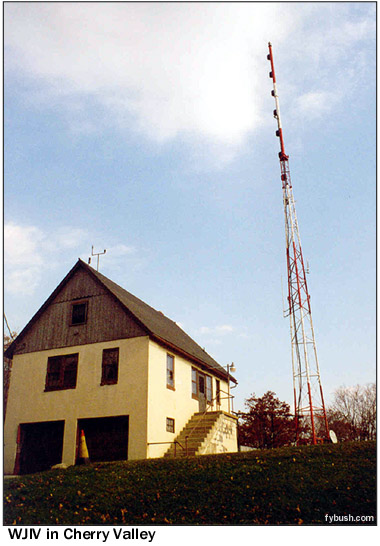 Yet all but two
of the original six stations survived right to this very day,
and in many cases their transmitter sites still look much like
they did back in 1948.
Yet all but two
of the original six stations survived right to this very day,
and in many cases their transmitter sites still look much like
they did back in 1948.
The network itself survived into the nineteen-fifties, albeit with some changes. Instead of originating most of its programming from Ithaca, where WYFC disappeared from the scene early on in favor of WHCU-FM, RRN began picking up the classical music programs of WQXR-FM (96.3) in New York City, which were received and rebroadcast by WKIP-FM (104.7) in Poughkeepsie and then picked up at Cherry Valley.
Each of the four remaining original stations ended up with new call letters: WRRL Wethersfield, WRRE Bristol Center (which moved to 95.1), WRRD DeRuyter and WRRC Cherry Valley. Later in the fifties, the old Ithaca site on Conn Hill in Newfield returned to the airwaves on 103.7, using the calls WRRA. Turin was simply gone, and up in Ogdensburg, WSLB-FM had signed off as well. (WSLB would get another FM allocation, at much lower power, later on.)
Each hour, the engineers who lived on-site at the various transmitter sites provided a live weather report, relayed over the inter-city FM network to the few FM households out there in upstate New York.
And after carrying the torch for FM during the long, lonely years of the fifties, when the RRN stations made up nearly half of the entire FM dial in upstate New York, the network finally sold out in the early sixties.
The new owner was a young preacher named Pat Robertson, who renamed the stations the "Christian Broadcasting Network," or CBN.
By this point, the five stations again had new calls: WBIV Wethersfield, WMIV Bristol Center (which later identified as "South Bristol"), WOIV DeRuyter, WJIV Cherry Valley and WEIV Ithaca. Those calls would sometimes be heard on-air as the "Ivy Network" during the nearly two decades of CBN FM network operation in upstate New York. Studios for the network were apparently located at the WEIV site (below, now bricked up and painted green), identified as "Sonshine Mountain, Newfield, N.Y."
In the early eighties, Robertson's focus had shifted to television, and the Ivy Network stations went up for sale individually. More than thirty years after they were built, several of the stations were finally ready to be noticed in larger upstate cities.
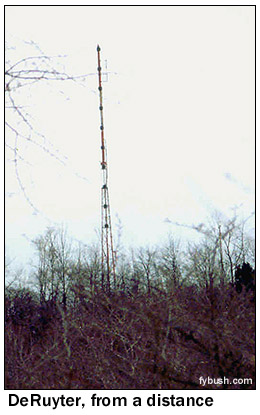 The old engineers
had chosen well; the transmitter sites, each more than 2,000
feet above sea level, provided some of the region's best FM signals.
Now that FM radios were becoming common and the big-city allocations
were full, it made sense to use these signals for their urban
coverage as well as their rural reach.
The old engineers
had chosen well; the transmitter sites, each more than 2,000
feet above sea level, provided some of the region's best FM signals.
Now that FM radios were becoming common and the big-city allocations
were full, it made sense to use these signals for their urban
coverage as well as their rural reach.
WJIV stayed religious and kept its calls under new owner Floyd Dykeman, but the studios eventually migrated from "Victory Mountain" above Cherry Valley to an office park in Albany. With a network of translators to aid its signal, WJIV became a major religious radio presence in eastern New York. In 2000, WJIV was sold to Jon Yinger's Midwest Broadcasting, which continued the station's tradition of religious radio for the Albany market.
DeRuyter's path was a bit more complex. The WOIV calls stayed in place for more than a decade after Forus Communications bought the station in 1981, joined by AM affiliate WSIV (1540) East Syracuse and operating from WSIV's little studio at its East Syracuse transmitter site.
In the nineties, 105.1 returned to its classical music roots after a decade of religion, changing calls to WVOA under new owner Craig Fox's Cram Communications. That didn't last long, with religion returning to WVOA's airwaves for most of the rest of the decade, joined in 1999 by a low-power FM sister, WNDR (later WVOQ) 103.9 Mexico.
In 2000, Clear Channel bought WVOA. The WVOA calls and programming moved to 103.9, and after a brief stint with the WVOQ calls, 105.1 began simulcasting country powerhouse WBBS-FM (104.7 Fulton-Syracuse) under the new calls WXBB, amidst much talk of plans to move the transmitter closer to Syracuse itself.
(Under Cram ownership, WVOA had at one point applied to change its city of license to Chittenango, but no actual application to move the station followed.)
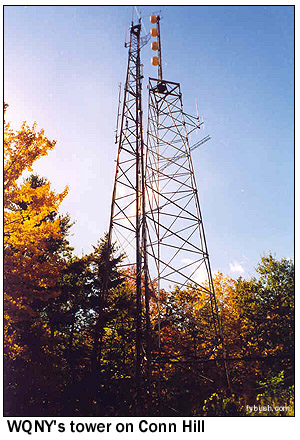
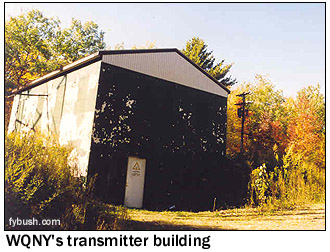 In
Ithaca, WEIV was sold to George Kimble's Kimmanger Communications
in 1982, changing calls to WQNY and building new studios at 122
S. Cayuga Street in downtown Ithaca.
In
Ithaca, WEIV was sold to George Kimble's Kimmanger Communications
in 1982, changing calls to WQNY and building new studios at 122
S. Cayuga Street in downtown Ithaca.
WQNY began as a beautiful-music station, but soon became a hit radio outlet. Under a succession of owners, it then flipped to soft adult contemporary and eventually to country music under Eagle Broadcasting, which coupled the station first with WTKO (1470) and eventually with Ithaca's two other big commercial voices, WHCU (870) and WYXL (97.3).
No doubt few appreciated the irony that both of the Rural network's Ithaca FMs had finally ended up under a common roof, out in the new studio facility on Hanshaw Road.
The South Bristol station, which had always had a good signal into Rochester, began to aggressively target the market once it was sold to Empire Media in 1982. Under the new calls WYLF, "Life 95" signed up with the Music of Your Life service to provide adult standards to Rochester from its studios in an old house on Rochester Road in Canandaigua and a sales office on Commercial Street in East Rochester.
In 1985, the station was sold to New England broadcasters Arnold Lerner and Ron Frizzell, operating as the "Great Lakes Wireless Talking Machine Company." The next summer, WYLF changed calls to WZSH, "Wish 95," and added a translator on the East Rochester water tower (W288AR on 105.5) to better reach Rochester listeners. (The station's soft AC format and logo matched sister station WSSH in Lowell, near Boston.)
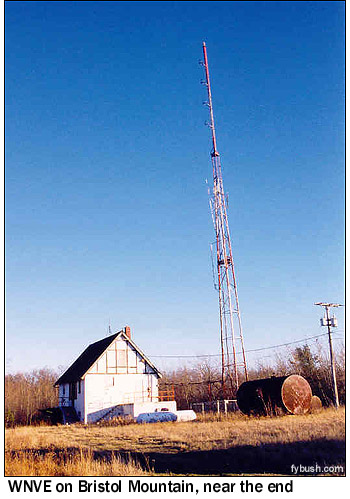 A few months later,
WZSH left the Canandaigua studios for new digs in the Piano Works
building in East Rochester, where the station would remain for
a decade, albeit with two more call and format changes. 1991
brought WRQI, "Rock-It 95," playing classic rock -
and adding Howard Stern's morning show a few years later.
A few months later,
WZSH left the Canandaigua studios for new digs in the Piano Works
building in East Rochester, where the station would remain for
a decade, albeit with two more call and format changes. 1991
brought WRQI, "Rock-It 95," playing classic rock -
and adding Howard Stern's morning show a few years later.
In 1995, the music mix edged towards modern rock when WRQI became WNVE, "the Nerve." W288AR went away, replaced by W238AB, a 250-watt powerhouse translator on 95.5 broadcasting from Pinnacle Hill in the heart of the Rochester market (and inspiring the "95-1, 95-5" IDs that would be heard incessantly for the rest of the decade.) The transmitter briefly moved to a Rochester Telephone tower in Farmington, closer to Rochester, but interference complaints from neighbors soon forced a return to Bristol Mountain.
Frizzell and Lerner entered a joint sales agreement with American Radio Systems in 1996, which led to a sale to Jacor the next year, and then the fun really began. WNVE's studios moved to the Jacor (now Clear Channel) cluster in downtown Rochester, and the station began laying plans to leave its old South Bristol site forever. Clear Channel applied to move the 95.1 allocation to Honeoye Falls, trading it for a 107.3A allocation that belonged to now-sister station WLCL.
The move was made in the summer of 2001, with WNVE moving its antenna to the WVOR (100.5 Rochester) site on Baker Hill in Victor, within easy sight of the Rochester skyline. WLCL may eventually end up at the old South Bristol mountaintop, but for now that site sits nearly silent. (Religious WCIY 88.9 went on the air down the road from WNVE in the late nineties.)
The transmitter move made W238AB unnecessary, and that 95.5 signal disappeared from Pinnacle Hill just as 2001 came to a close.
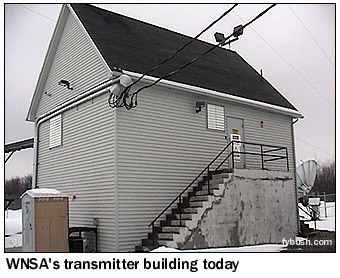
 And that brings us
to Wethersfield, a little bump in the road (state route 78, to
be precise) in Wyoming County, halfway between Buffalo and Rochester
if you're going a bit out of the way.
And that brings us
to Wethersfield, a little bump in the road (state route 78, to
be precise) in Wyoming County, halfway between Buffalo and Rochester
if you're going a bit out of the way.
WBIV was sold in 1982 to "Stereo Seven Associates", and thus began one of the strangest chapters in Western New York radio.
Renamed WUWU, the station moved into a storefront in a strip mall in East Aurora and began giving the region a belated dose of the progressive rock FM revolution.
Announcing its presence with a day-long loop of "Papa Oom Mow Mow," WUWU settled down for two years of anything-goes rock programming that drew little in the way of ratings and revenue, but plenty in the way of audience devotion in both Buffalo and Rochester, thanks to a signal that reached well into both cities, another tribute to the excellent engineering choices made way back in 1947.
It couldn't last, of course (though your editor would dearly love to find anyone with tapes of the station), and by 1984 WUWU had segued to a jazz format, then to beautiful music as WEZQ. Sold to John Casciani in 1988, the station relocated from East Aurora to an upscale office building at 5500 Main Street in Williamsville and became new-age WBMW, then, in 1990, easy-listening WEZQ. That lasted just three years, replaced in 1993 by country WNUC, "New Country."
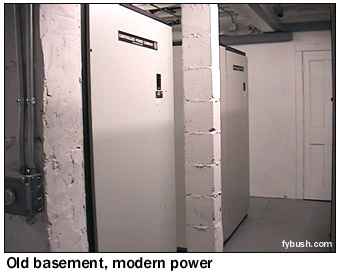 WNUC
added translators on 107.3 in Williamsville (at the studios)
and on 105.3 in downtown Buffalo to help its signal in the Queen
City, but the station remained an also-ran in the ratings for
the rest of the nineties. Then, in 2000, Casciani sold WNUC to
cable giant Adelphia, which already owned Buffalo's biggest cable
system and the Empire Sports Network, not to mention a little
team called the Buffalo Sabres.
WNUC
added translators on 107.3 in Williamsville (at the studios)
and on 105.3 in downtown Buffalo to help its signal in the Queen
City, but the station remained an also-ran in the ratings for
the rest of the nineties. Then, in 2000, Casciani sold WNUC to
cable giant Adelphia, which already owned Buffalo's biggest cable
system and the Empire Sports Network, not to mention a little
team called the Buffalo Sabres.
Empire poured, quite literally, millions of dollars into renovating the Wethersfield site, turning a half-century old relic into one of the region's most sophisticated FM plants.
The basement level, where Rural Radio engineers once parked their Jeeps (you can see a similar garage in the WJIV picture at the top of the page), is now home to a room full of generator equipment and uninterruptible power supplies. The many two-way operators who use this site, from area hams to the government, now share a master antenna on the tower that WUWU put up in the early 80s, all fed through a combiner located next to the power room.
Upstairs, new transmitters were brought in to enable the renamed WNSA ("Niagara's Sports Authority") to achieve its full licensed power for the first time. They're fed by a studio-transmitter link that's as remarkable, in its own way, as the FM interlink that first fed this site in 1948.
Remember that Empire, being a regional cable network, has plenty of satellite capability - so it was a natural decision to put WNSA's audio on a subcarrier of that satellite signal in order to reach the transmitter site in Wethersfield, some 35 miles from the Empire headquarters in East Aurora.
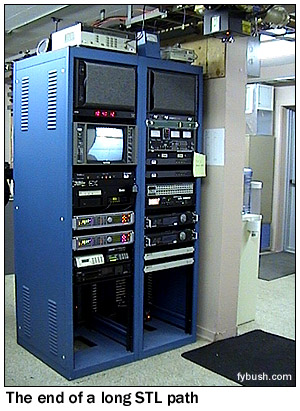
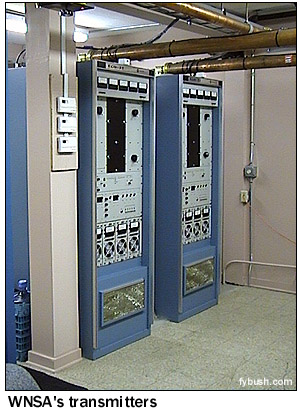 With
two big dishes out by the side of the building (what would RRN's
engineers have made of those, we wonder), we're told the
WNSA audio survives even the worst of sun fades to reach the
site.
With
two big dishes out by the side of the building (what would RRN's
engineers have made of those, we wonder), we're told the
WNSA audio survives even the worst of sun fades to reach the
site.
And in glorious mono, from a brand-new ERI directional antenna that puts out 18 kW ERP everywhere except in the direction of 107.9 in Burlington, Ontario (an unfortunate short-spacing that slipped through in the early 1980s), WNSA still reaches clearly into Rochester and most of the Buffalo area, helped along by those two translators (the 107.3 was moved to Adelphia's cable tower on LaSalle Street in Buffalo, while the 105.3 moved to 104.7 in downtown Buffalo last year) to improve in-city coverage.
One bit of history had to go, alas: scroll back up to the top of the page and you can see the original RRN self-supporting tower along with a later guyed tower next to the main 107.7 stick. We're told Adelphia considered keeping the old RRN stick, but it was simply beyond salvaging.
So while WNSA provides a modern update to the RRN saga (complete with vinyl siding over the old RRN concrete block), the other three original sites, especially Bristol and Cherry Valley (DeRuyter lies down a gated road and I've never been all the way to the transmitter building; Ithaca appears to have been extensively modified, if in fact anything of the original 1948 structure survives) offer a fascinating look back in time at the earliest days of FM radio in upstate New York to those who know, as you now do, the very long history that lies there.
Copious thanks to WNSA chief engineer Mark Ewart Sr. for opening his site to me in January 2002. Thanks, also, to Norm Gagnon's GGN Information Services Web site for compiling the stories of the early days of RRN. Go visit Norm's site -- now! -- to see an actual RRN coverage map (part of the "Poster Series" of links) and to read RRN engineers' own account of the birth of their network (in the "Articles" section).
- Previous Site of the Week: The Big One: WLW Cincinnati
- Next Week: Paterson Plank Road, East Rutherford, N.J: WADO and WNNY
- How can you help support Site of the Week? Click here!
- Submit your suggestions for a future Site of the Week!
